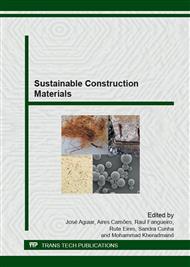[1]
H.E. Gram. Natural fibre concrete roofing. In: NATURAL FIBRE REINFORCED CEMENT AND CONCRETE, V. 5, Anais… Edited by R.N. Swamy, Blackie and Son Ltd, London, 1988: 257-285.
Google Scholar
[2]
H.E. Gram. Durability of natural fibers in concrete, Swedish cement and concrete research institute, Research Fo. 1: 83, Stockolm. 1983, 255p.
Google Scholar
[3]
R.D. Toledo Filho, K. Ghavami, G.L. England and K. Scrinever. Development of vegetable fibre-mortar composites of improved durability. Cement And Concrete Composites. v. 25, n. 2, pp.185-196, (2003).
DOI: 10.1016/s0958-9465(02)00018-5
Google Scholar
[4]
G.H.D. Tonoli, S.F. Santos, W.N. Santos and H. Savastano Jr. Thermal performance of sisal fiber-cement roofing tiles for rural constructions, Scientia Agricola. Piracicaba, v. 68, n. 1, pp.1-7, January/February (2011).
DOI: 10.1590/s0103-90162011000100001
Google Scholar
[5]
J. Fiorelli, R. Schmidt, C.Y. Kawabata, C.E.L. Oliveira, Savastano Jr and J.A. Rossignolo. Eficiência térmica de telhas onduladas de fibrocimento aplicadas em abrigos individuais para bezerros expostos ao sol e à sombra. Ciência Rural. Santa Maria, v. 42, n. 1, pp.64-7, (2012).
DOI: 10.1590/s0103-84782012000100011
Google Scholar
[6]
K. Bilba and M. -A Arsene. Silane treatment of bagasse fiber for reinforcement of cementitious composites. Composites Part A, v. 39, pp.1488-95, (2008).
DOI: 10.1016/j.compositesa.2008.05.013
Google Scholar
[7]
J. Claramunt, M. Ardanuy and J.A. Garcia-Hortal. Effect of drying and rewetting cycles on the structure and physicochemical characteristics of softwood fibres for reinforcement of cementitious composites, Carbohydrate Polymers. v. 79, pp.200-205, (2010).
DOI: 10.1016/j.carbpol.2009.07.057
Google Scholar
[8]
J.M.B. F. Diniz, M. H, Gil and J.A.A.M. Castro. Hornification—its origin and interpretation in wood pulps. Wood Sci Technol. v. 37, p.489–494, (2004).
DOI: 10.1007/s00226-003-0216-2
Google Scholar
[9]
A.A. Brancato. Effect of progressive recycling on cellulose fiber surface properties. Thesis of D. Sc, - School of Chemical and Biomolecular Engineering, Georgia Institute of Technology. December (2008).
Google Scholar
[10]
S. Ferreira. Influência da hornificação na aderência fibra-matriz e no comportamento mecânico de compósitos cimentícios reforçados com fibras curtas de sisal. Tese de M. Sc. em Engenharia Civil e Ambiental, UEFS, Feira de Santana, Brasil, (2012).
DOI: 10.17771/pucrio.acad.59447
Google Scholar
[11]
P.R.L. Lima and R.D. Toledo Filho. Uso de metacaulinita para incremento da durabilidade de compósitos à base de cimento reforçados com fibras de sisal. Ambiente Construído, v. 8, n. 4, pp.7-19, (2008).
DOI: 10.11606/d.3.2010.tde-30122014-162204
Google Scholar
[12]
Associação Brasileira de Normas Técnicas. Argamassa para assentamento e revestimento de paredes e tetos: determinação da resistência à tração na flexão e à compressão: NBR 13279. Rio de Janeiro, (2005).
Google Scholar
[13]
ASTM C 1557. Standard Test Method for Tensile Strength and Young's Modulus of Fibers, (2003).
Google Scholar
[14]
S. Ferreira, P.R.L. Lima, F. Silva and R.D. Toledo Filho. Effect of sisal fiber hornification on the adhesion with portland cement matrices. Materia. v. 17, pp.1024-1034, (2012).
Google Scholar
[15]
J. Claramunt, M. Ardanuy, J.A. Garcia-Hortal and R.D. Tolêdo Filho. The hornification of vegetable fibers to improve the durability of cement mortar composites. Cement & Concrete Composites. v. 33, pp.586-595, (2011).
DOI: 10.1016/j.cemconcomp.2011.03.003
Google Scholar
[16]
P.J. Herrera-Franco, A.A. Valadez-Gonzalez. A study of the mechanical properties of short natural-fiber reinforced composites. Composites: Part B, v. 36, p.597–608, (2005).
DOI: 10.1016/j.compositesb.2005.04.001
Google Scholar
[17]
J.T. Kim, A.N. Netravali. A study of the mechanical properties of short natural-fiber reinforced composites. Composites: Part B. v. 36, p.597–608, (2005).
DOI: 10.1016/j.compositesb.2005.04.001
Google Scholar
[18]
T.P. Mohan, K. Kanny. Chemical treatment of sisal fiber using alkali and clay method. Composites: Part A. v. 43, p.1989–1998, (2012).
DOI: 10.1016/j.compositesa.2012.07.012
Google Scholar
[19]
L. Salmén, A.M. Olsson, J.S. Stevanic and K. Radotic. Structural Organisation of the Wood Polymers in the Wood Fibre Structure. Biosources. v. 7, pp.521-532, (2012).
DOI: 10.15376/biores.7.1.521-532
Google Scholar


